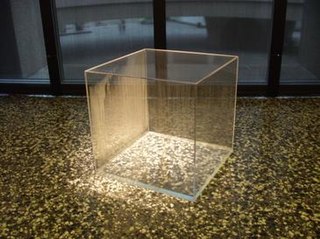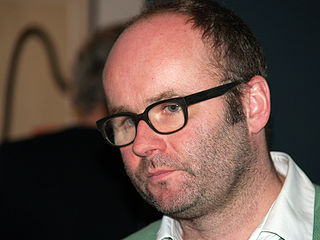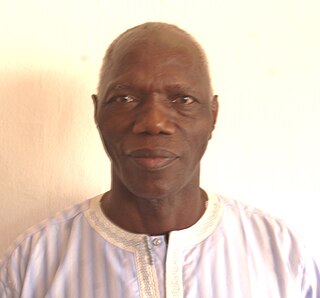Related Research Articles
In geometry, a Platonic solid is a convex, regular polyhedron in three-dimensional Euclidean space. Being a regular polyhedron means that the faces are congruent regular polygons, and the same number of faces meet at each vertex. There are only five such polyhedra:

Generative art is post-conceptual art that has been created with the use of an autonomous system. An autonomous system in this context is generally one that is non-human and can independently determine features of an artwork that would otherwise require decisions made directly by the artist. In some cases the human creator may claim that the generative system represents their own artistic idea, and in others that the system takes on the role of the creator.

The Venice Biennale is an international cultural exhibition hosted annually in Venice, Italy, by the Biennale Foundation. It focuses on contemporary art, and includes events for art, contemporary dance, architecture, cinema, and theatre. Two main components of the festival are known as the Art Biennale and the Architecture Biennale, which are held in alternating years. The others – Biennale Musica, Biennale Teatro, Venice Film Festival, and Venice Dance Biennale – are held annually. The main exhibition held in Castello alternates between art and architecture, and there are around 30 permanent pavilions built by different countries.
Manuel Franquelo was a Spanish painter and mixed media sculptor.
SHA-2 is a set of cryptographic hash functions designed by the United States National Security Agency (NSA) and first published in 2001. They are built using the Merkle–Damgård construction, from a one-way compression function itself built using the Davies–Meyer structure from a specialized block cipher.
Coop Himmelb(l)au is an architecture, urban planning, design and art firm founded in 1968 by Wolf D. Prix, Helmut Swiczinsky and Michael Holzer in Vienna, Austria.

Dominique Perrault is a French architect and urban planner. He became world known for the design of the French National Library, distinguished with the Silver medal for town planning in 1992 and the Mies van der Rohe Prize in 1996. In 2010 he was awarded the gold medal by the French Academy of Architecture for all his work. He was named as the 2015 Praemium Imperiale Laureate for Architecture.
Germano Celant was an Italian art historian, critic, and curator who coined the term "Arte Povera" in the 1967 Flash Art piece "Appunti Per Una Guerriglia", which would become the manifesto for the Arte Povera artistic and political movement. He wrote many articles and books on the subject.

Thomas Cyrill Demand is a German sculptor and photographer. He currently lives and works in Berlin and Los Angeles, and teaches at the University of Fine Arts, Hamburg. He makes photographs of three-dimensional models that look like real images of rooms and other spaces, often sites loaded with social and political meanings. Demand thus describes himself not as a photographer, but as a conceptual artist for whom photography is an intrinsic part of his creative process.

Abdoulaye Konaté is a Malian artist. He was born in Diré and lives and works in Bamako.

AES+F is a collective of four Russian artists: Tatiana Arzamasova, Lev Evzovich, Evgeny Svyatsky, and Vladimir Fridkes. It was first formed as AES Group in 1987 by Arzamasova, Evzovich, and Svyatsky, becoming AES+F when Fridkes joined in 1995. The collective works in photography, video, installation, and animation, as well as more traditional media, such as painting, drawing, and sculpture. AES+F's early work included performance, installation, painting, and illustration. Well known for their monumental video-art installations that Gareth Harris describes as "monumental painting set in motion", AES+F create grand visual narratives that explore contemporary global values, vices and conflicts.

Joachim Sauter was a German media artist, designer and technology entrepreneur. He was appointed Professor for New Media Art and Design at the Universität der Künste Berlin, UdK in 1991, and in 1993 he created Terravision, before pursuing a lawsuit against Google for infringing the patent. He became an adjunct professor at UCLA, Los Angeles in 2001.

Jennifer Allora and Guillermo Calzadilla are a collaborative duo of visual artists who live and work in San Juan, Puerto Rico. They were the United States Representatives for the 2011 Venice Biennale, the 54th International Art Exhibition, in 2011.

Marco Maggi is a New York- and Uruguay-based artist whose work incorporates common materials such as office paper, aluminum foil, graphite, and apples to create micro drawings, sculptures, and macro installations.

Joris Hendricus Laarman is a Dutch designer, artist, furniture maker, and entrepreneur best known for his experimental designs inspired by emerging technologies. Laarman's projects are a blend of technology, art and design, with a focus on the potential of 3D printing. Major projects include 3D-printed stainless-steel bridge in Amsterdam, which showcases the potential for creating adaptive, lightweight, and uniquely designed structures using 3D printing. Laarman has also explored furniture design, including the 'Bone' series which used 3D-optimization software to achieve optimal construction. The designer's work often evokes a futuristic feel while nodding to historical art movements, exemplified by pieces like his "Digital Matter" series. When Laarman speaks about his work he discussed the implications and responsibilities that come with breakthrough technologies.
Defne Ayas is a curator, lecturer, and editor in the field of contemporary art and its institutions. Ayas directed, cofounded, curated, and advised a number of art institutes, initiatives and exhibition platforms across the globe, including in the United States, Netherlands, China and Hong Kong, South Korea, Russia, Lithuania, and Italy. Exploring art's role within social and political processes, Ayas is best known for conceiving innovative exhibition and biennale formats within diverse geographies, in each instance composing interdisciplinary frameworks that provide historical anchoring and engagement with local conditions. Working between Berlin and New York since 2018, she is currently serving as Senior Program Advisor and Curator at Large at Performa. Until June 2021, Ayas was also the Artistic Director of 2021 Gwangju Biennale, together with Natasha Ginwala.
Sonia Gomes is a Brazilian contemporary artist who lives and works in São Paulo, Brazil. Gomes frequently employs found objects and textiles in her works, twisting, stretching, and bundling them to fashion wiry or knotty sculptural forms.
Yuko Hasegawa is the director of the 21st Century Museum of Contemporary Art, Kanazawa and professor of curatorial and art theory at Tokyo University of the Arts.

The Australian pavilion is a structure that houses Australia's national representation during the Venice Biennale arts and architecture festivals. Although Australia has been represented at the arts festival since 1954, the first pavilion was only built in 1987, and replaced by a permanent structure in 2015.
References
- ↑ Future Cities: ECAADE 2010 : Proceedings of the 28th Conference on Education. 2010. ISBN 978-3728132796 . Retrieved 2013-11-01.
- ↑ "Computational Architecture: L-Systems". Michael Hansmeyer. Retrieved 2013-11-01.
- ↑ "Computational Architecture: Platonic Solids". Michael Hansmeyer. Retrieved 2013-11-01.
- ↑ Hansmeyer, Michael (2012-07-27). Building unimaginable shapes . Retrieved 2024-08-15– via www.ted.com.
- ↑ designboom, erika kim I. (2011-09-14). "michael hansmeyer at gwangju design biennale 2011" . Retrieved 2024-08-15.
- ↑ Laura Allsop for CNN. "Sci-fi 'gothic' architecture brought to life". CNN.com. Archived from the original on April 15, 2011. Retrieved 2013-11-01.
{{cite web}}:|author=has generic name (help) - ↑ "Architecture Record | McGraw-Hill Construction". Archrecord.construction.com. 2011-10-05. Retrieved 2013-11-01.
- ↑ "Michael Hansmeyer - Digital Grotesque I". Michael Hansmeyer. Retrieved 2024-08-15.
- ↑ "Grotto II". Centre Pompidou. Retrieved 2024-08-15.
- ↑ S.L, Factum Arte. "Factum Arte :: The Magic Flute". www.factum-arte.com. Retrieved 2024-08-15.